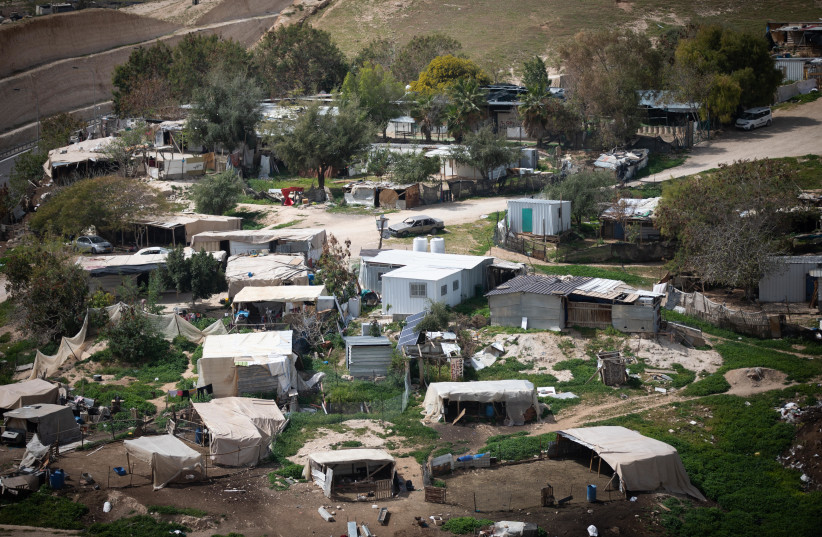The government must develop a plan to combat the threat Palestinian building poses to the future application of Israeli sovereignty over portions of the West Bank, the Knesset Foreign Affairs and Defense Committee told the National Security Council (NSC).
“We want to see some kind of a government plan as a response to what is going on,” FADC Chairman MK Yuli Edelstein (Likud) told The Jerusalem Post on Wednesday.
When the FADC reconvenes in October it will want to hear “what steps” the government is taking to address the issue which is preventing the development of Jewish building in Judea and Samaria, he said.
The FADC sent a letter to the NSC after it held a debate on the issue in the Knesset last week, in which it referenced a 2021 report on the matter from the Ministry of Intelligence.
MK Avi Boaron (Likud) quoted from the document which explained that there was a “Palestinian campaign to reshape the area,” through “political construction” to “strategically influence the balance of power, from a political or security perspective.”

The battle over West Bank Area C
Right-wing politicians linked the issue of a PA plan to seize control of territory to the battle over Area C, which is under IDF military and civilian control. The PA, however, holds that Area C of the West Bank must be part of the final borders of a Palestinian state. In contrast, the Israeli Right holds that Israeli sovereignty should be applied to this region, which makes up 60% of the West Bank and is where all the settlements are located.
Right-wing politicians have focused in particular on the issue of illegal Palestinian construction in Area C, which they say is part of a plan to seize these areas for part of a future Palestinian state.
Boaron urged the FADC to expand the prism of how it views the issue to also consider Areas A and B of the West Bank, which are under PA control.
All Palestinian construction in those areas, where the bulk of the Palestinian population lives, is under PA control and Israel has no authority over it.
Boaron, however, explained that in the last decade, the PA has strategically built in sections of Areas A and B that border Area C, to deliberately stymie Israel settler growth.
A resident of the Amihai settlement, Boaron explained that since the community was first established in 2018, the Palestinians have built homes close by in Area B. He noted the same phenomenon near the settlements of Ma’aleh Leovona, Elon Moreh, Itamar, Ariel, and in the Jordan Valley.
Boaron said the problem was well laid out in the 2021 Ministry of Intelligence report which stated that: “The Palestinian moves deliberately disregard the definitions of Areas A, B, and C. “Therefore, the seizures in Area C are in its view a logical extension of its ‘legitimate’ moves in Areas A and B. Therefore, we recommend that all of Israel’s moves be planned through a perspective that will also include tracking of (and responding to) the Palestinian activities in Area A and B, particularly in those areas adjoining Area C, which have potential future security impacts on Area C.”
The IDF, Boaron said, must view such Palestinian building close to Area C as a strategic threat, and work to remove it for that reason.
The FADC also discussed illegal Palestinian building in Area C of the West Bank.
New settler homes under construction
Lt.-Col. Adam Avidan, head of infrastructure at the IDF Civil Administration in Judea and Samaria, provided an overall view of the difference between Israeli settler construction and Palestinian building in Area C.
On average, he said, the Civil Administration’s Higher Planning Council for Judea and Samaria annually advanced plans for some 5,000 to 10,000 settler homes, compared to only a few hundred for Palestinians.
Some 90-95% of Palestinian requests for housing permits are rejected, he said, explaining that many of the requests are for retroactive legalization.
Some 60-70% of the Israeli plans are approved. In 2022, the Civil Administration identified 1,600 new illegal Palestinian structures. It also razed 500 such structures, but not necessarily the ones that were identified that year.
In the first half of 2023, 1,000 new illegal Palestinian structures were identified and close to 220 were razed.
He described a situation in which the rate of illegal Palestinian construction vastly outpaced the demolition rate.
The Civil Administration also identified 340 new illegal Jewish structures in 2022, of which 67 were razed. In 2023, 266 new illegal Israeli structures were identified and 21 were destroyed.
Overall, he said, there are some 8,000 illegal Palestinian structures in Area C, most of whom have standing demolition orders.
MK Gilad Kariv (Labor) added that based on IDF information he had received, only 200 building permits had been issued for Palestinians from 2000-2020.
